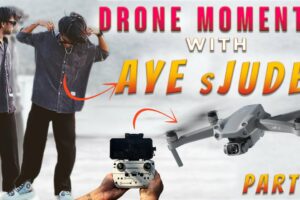
— PLEASE READ ALL INFO BELOW BEFORE POSTING! —
I planned to perform a short GPS controlled high altitude flight, going straight up, and then straight down again.
When initating the descent, something did not work out as expected, and less than ten minutes later the hexacopter crashed because the failed descent attempts had drained the battery.
Technical explanation to what actually happened:
The GPS mode prioritized staying in place over descending. The winds were so strong that the engines had to work hard to keep the multirotor in place. When I told the multirotor to descend it basically said “I’m afraid I can’t do that, because you told me to stay in this position, and if I slow down the motors to descend, I would also start moving sideways with the wind”. The solution was to disengage the GPS mode.
Important background information:
This video depicts a very dangerous situation that could have ended up much worse than it actually did.
I was very lucky not to cause any damage on the ground to either living beings or property.
I am not proud of this particular flight, and my main reason for putting the video on YouTube is to inform others and hopefully help them avoid making the same mistake(s) I did.
My arguments for performing a high altitude flight at all were as follows:
– No airplanes in this area ever fly as low as I did in the video
– There is generally not much air traffic in this area at all
– I checked with flightradar24.com before flying
– Military, police, and emergency flights are virtually non-existant in this area
– The multirotor was supposed to go straight up and straight down again
Knowing all of this, I still realize it was a mistake flying that high, especially on this particular occasion. The wind on the ground was not very strong, but higher up, the wind was so strong that the hexacopter had to struggle to stay in position. When I started descending, the hexacopter did not seem to respond to my command, and the only way to make it respond was to disconnect the GPS mode. It then started descending, but it also started moving away with the wind.
Facts to be noted before commenting on the video:
I DO NOT PERFORM HIGH ALTITUDE FLIGHTS ANYMORE, NOR DO I FLY OVER POPULATED AREAS. Hence, it is unnecessary to ask me to stop flying like I did in the video, since it definitely won’t happen again anyway. The crash was a harsh wakeup call that totally made me rethink my attitude towards multirotor flying, and I realize now that high altitude flights and flights over populated areas are way too risky and dangerous.
THE MULTIROTOR DID NOT CAUSE ANY DAMAGE ON THE GROUND, TO EITHER PEOPLE, ANIMALS, OR PROPERTY. Having said this, I am fully aware that something disastrous could have happened, and there is no need to keep reminding me about that fact.
I WAS CONFIDENT THAT THE MULTIROTOR WOULD AUTOMATICALLY PERFORM A CONTROLLED LANDING IF THE BATTERY LEVEL REACHED ITS SPECIFIED MINIMUM. After reading the documentation, I felt reassured knowing that I had specified two battery level limits, where the second (lowest) limit, if reached, would initiate a forced automatic landing. Apparently this never happened, so this was either a misunderstanding on my behalf, or unclear documentation, or a combination of both.
Also, I do not live in the US, so the FAA will probably not be too interested in this flight.
My advice to any and all multirotor flyers out there: Never ever take any unnecessary risks. It is never worth it. I got away with it this time, but I could as well have ended up hurting or even killing someone on the ground.
Equipment:
– Frame: DJI F550
– Gyro: DJI Naza v2 with GPS
– Gimbal: DJI Zenmuse H3-2D
– Camera: GoPro Hero3, Black Edition
– Radio: Futaba T14SG with receiver R7008SB
– Battery: Li-Po 4S (14.8V), 6200 mAh
– Motors: Stock F550 (DJI 2212/920)
– Esc: Stock F550 (DJI ESC 30 amps OPTO)
– Propellers: Stock DJI 10″
source







This is an example why FAA and countires all around the world set up severe rules about flying RPAS, just to avoid idiots like this one who endanger aircrafts full of people up in the air.
btw its NOT a helicopter.. its a drone
8:53 *MAYDAY MAYDAY MAYDAY!*
Above the clouds trying to fly back down, would it been better to kill the engine, free fall till near ground level? I'm not sure how this stuff works but that could be a solution
Virtue Signalers 2014: "you're stupid risking others airplane lives"
Virtue Signalers 1903: "you're stupid Wright Brothers for risking your airplane lives"
People never stop judging do they? Always holier than thou.
I say Fly High Stefan! Every day is a risk worth taking. Driving a car is 1000X more dangerous than what happened here. Humanity has lost its way when it can no longer assess risk and calculate true danger from contrived ones.
Even though this is dangerous, yadda yadda yadda, this is one of the videos that got me really interested in flying drones 🙂
can it do flips though
The video was entertaining and had some neat scenes but as both a commercial fixed wing pilot AND an RC plane / multi rotor pilot, this kind of flying could be dangerous in most parts of the world. We must respect each other’s air space to avoid possible fatal accidents.
I knew soon as you got above the clouds, things were going to become difficult. The wind speed up there is incredible.
You are lucky an aircraft wasn't coming through there. WOW! Incredible.
Glad the only damage was to the multirotor and your ego. Lesson learned. I paused the video at 10:26 and saw where it landed. Just wondering why you couldn't have found it. I fly a Phantom 3 Pro.
Congratulations on the beautiful flight. Just a guess, noticing low battery power would turn off the drone so that it would plummet to a higher altitude and reconnect it for undamaged landing. Would this maneuver be possible? A hug and good luck.im fromBrasil
1. Hovering above the clouds.
2. Plane hits your hexacopter.
3. Plane with people on board crashes and all of them dies.
4. You pretending this doesn´t happens.
5. You in jail for rest of your life.
Sorry for bad English 🙂
So stupid ! That is why the law will be more and more restrictive because of irresponsible people like you. You could have killed someone. ??
Hence the keep it in sight rule. Above those thick clouds, it was no longer in sight…..
Pls, don‘t fly that high again.
What a adventure?
Nice video but it’s possible to have this hexacopter on sale?
좋아요 ???
The video could have been uploaded by the person who found it & it probibly would have gone viral . Listed as ….look what I found. LOL